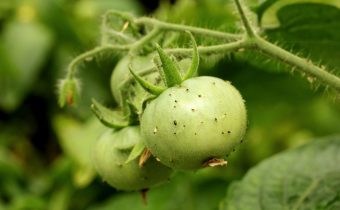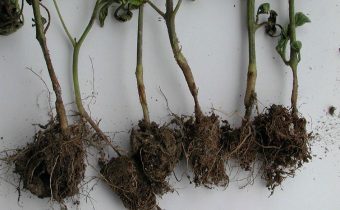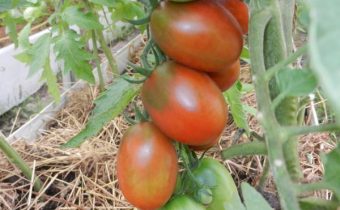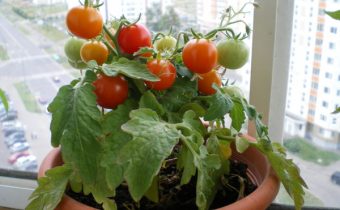When should pick tomatoes in the greenhouse?
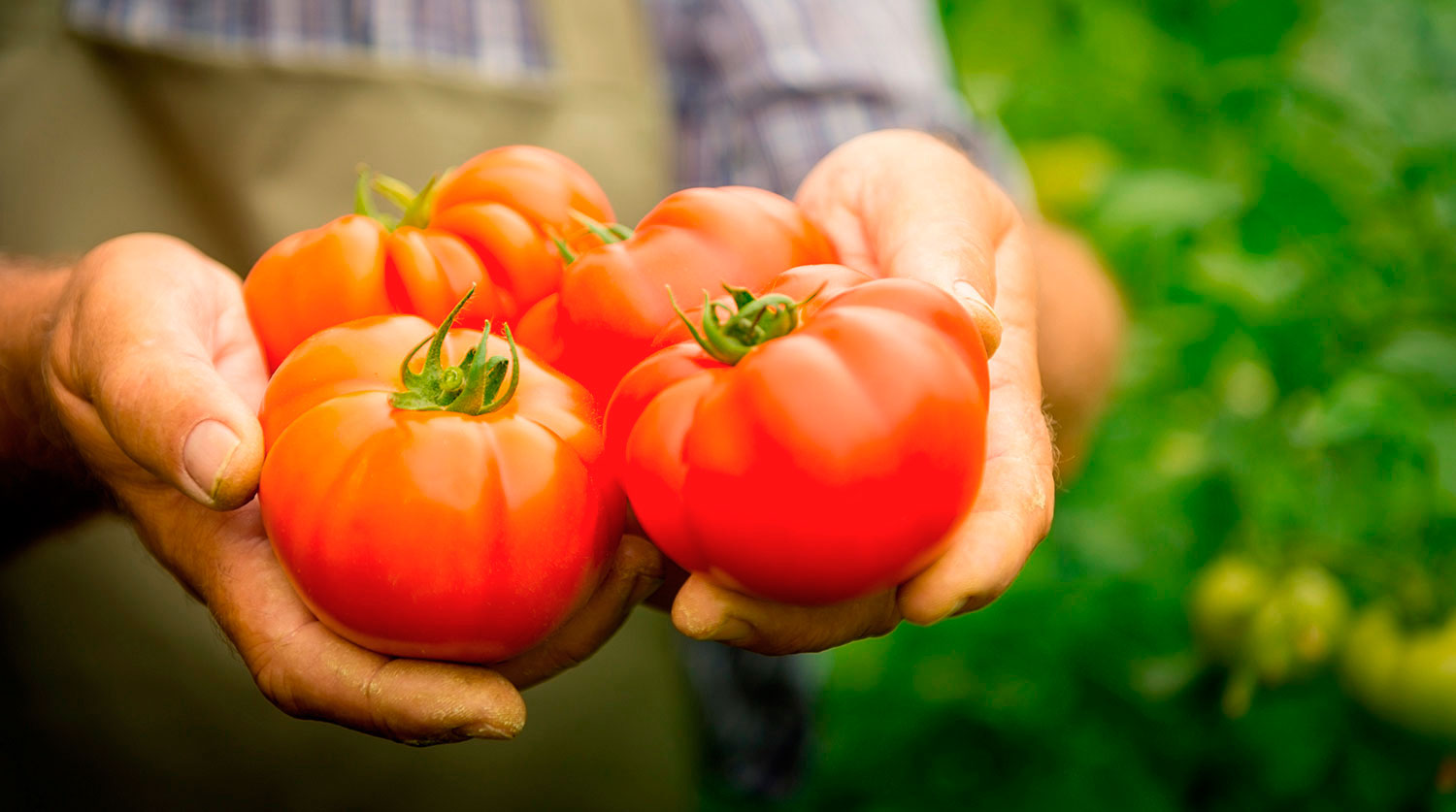
Tomatoes are grown in greenhouses in order to get an early harvest and to protect the thermophilic culture from weather disasters. The ripening period is extended over time and it is not always possible to correctly navigate the timing of harvesting. Knowledge of certain rules of collection and storage will help to get the maximum amount of the crop and save it for a long time.
What determines the time of cleaning
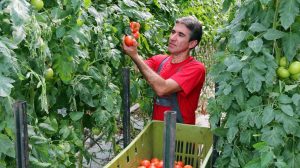 Terms of harvesting tomatoes depend on the purpose of collection: eating, processing immediately after harvesting or later, storage, forced collection due to unforeseen circumstances. In addition to the goals, other important reasons also affect the timing.
Terms of harvesting tomatoes depend on the purpose of collection: eating, processing immediately after harvesting or later, storage, forced collection due to unforeseen circumstances. In addition to the goals, other important reasons also affect the timing.
Factors affecting the timing of cleaning:
- weather conditions - in wet and cool weather, tomatoes are harvested earlier in order to prevent the occurrence of infections, leaving only small fruits on the bushes;
- varietal affiliation - early, mid-season, late-ripening variety;
- growing conditions - in greenhouses with different coating conditions are slightly, but differ;
- fertilizer use, soil composition, care.
Reference!
Early and early grades begin to ripen in mid-July, mid-ripening - in late July, late-ripening - in August.
Stages of ripening
The purpose of the collection determines the degree of maturity to harvest the fruit, for example, tomatoes can be used for eating, ripened on the bushes, and ripened will be suitable for harvesting and eating in late autumn.
Categories of fruit ripeness and uses
| Degree of ripening | Signs of | Terms of ripening, application |
| Unripe | Very tight, resilient. | Not collectable, as it gains weight and grows. |
| Dairy
|
The peel is light green with a whitish tinge, the pulp on the cut is pink (yellow). | Ripens 3-4 weeks, long stored. |
| Blank | The peel gets a brown (yellowish) shade. | It matures in 7-10 days, you can store. |
| Complete | Saturated color in accordance with the grade. | Eating, on blanks, is not stored. |
When and how to collect
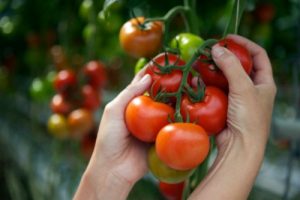 Tomatoes that have not gained weight and size cannot be harvested - they simply will not ripen, even if they lie for a long time.
Tomatoes that have not gained weight and size cannot be harvested - they simply will not ripen, even if they lie for a long time.
At the stage of milky ripeness, large fruits are removed, regardless of the weather. It is too early to use them, but under the right conditions they will ripen well, and the remaining small tomatoes will gain weight faster, more new ovaries will form. Sometimes "dairy" tomatoes are removed forcedly, in order to preserve the crop when infected with late blight or during prolonged prolonged rains and low temperatures. If you do not, you can destroy the entire crop.
At the stage of blanket ripeness it is recommended to remove all the tomatoes, if you do not need to leave them before full maturity for eating and for harvesting immediately after harvest. You can collect the fruits that have turned brown at least one side.
Fully ripened tomatoes are not subject to long-term storage, they are consumed within a few days or allowed on preforms.
Reference!
Tomatoes for seeds should ripen directly on the bush - they are removed when they become juicy and soft.
Collection rules:
- cleaning is carried out in dry, preferably warm, weather early in the morning, while the sun is less active;
- it is recommended to leave the stem - so tomatoes are stored better;
- collection is carried out every 3-5 days;
- during mass ripening, the interval is reduced to 2-3 days;
- in late summer or early autumn, if the temperature is above + 8 ° C, it is possible to allow the fruit to ripen on the bush;
- the whole crop is harvested at a temperature below + 7 ° .. + 8 ° C.
Ripening of green fruits (tomato ripening)
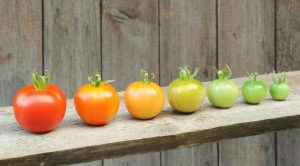 Choosing a place for ripening, you need to consider that at temperatures below 5 ° -6 ° C deteriorating taste of tomatoes, and they lose most of the beneficial properties, so cold rooms are not suitable. Green tomatoes should be brought to full ripeness in a warm room (15 ° -20 ° C) - at high temperatures the coloring pigment does not stand out, the fruits do not ripen.
Choosing a place for ripening, you need to consider that at temperatures below 5 ° -6 ° C deteriorating taste of tomatoes, and they lose most of the beneficial properties, so cold rooms are not suitable. Green tomatoes should be brought to full ripeness in a warm room (15 ° -20 ° C) - at high temperatures the coloring pigment does not stand out, the fruits do not ripen.
How to add tomatoes:
- choose a dry, dark, well-ventilated room (15 ° -20 ° C);
- spread out the tomatoes in layers (1-3) in containers with ventilation openings, shift them with paper or pour in sawdust;
- put 1-2 ripe fruits in each container - the ethylene gas they release accelerates ripening;
- ripening time can be postponed - periodically seasoning tomatoes should be removed.
Tomato storage
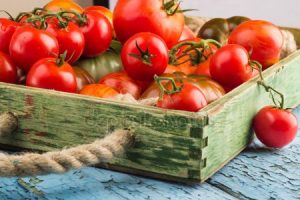 Tomatoes of different degrees of ripeness are put in storage - this makes it possible to ripen gradually and consume tomatoes for a long time.
Tomatoes of different degrees of ripeness are put in storage - this makes it possible to ripen gradually and consume tomatoes for a long time.
The collected fruits should be sorted by size and degree of ripening, folded separately uneven, with minor injuries - they can be used to make juice, paste. Large tomatoes ripen faster, so putting them together with small ones is not necessary.
After sorting, they are laid out in layers (1-3) in containers, shifted with newspapers, sawdust, straw and cleaned in a dry room with the appropriate temperature and humidity of 80-85%. Increased humidity leads to crop damage.and low contributes to the loss taste and technical qualities.
Important!
The storage temperature of ripe tomatoes is 1 ° -2 ° C, the blanse tomatoes are 4 ° -6 ° C, greens are 10 ° -12 ° C.
Boxes should be periodically checked and re-sorted, removing ripe and shifting ripe tomatoes to brown.
Ripe tomatoes in a cool room are stored in a box or in a box, but not in a package, where they quickly deteriorate.
Other storage methods:
- in the autumn, dig up a bush of tomatoes with fruits and leaves along with a clod of earth and hang them up (put a plastic bag on them) in the basement (10 ° -12 ° C);
- wrap fruits of breast maturity with a cloth (paper), fold them into boxes with a straw up and put them in a cellar (12 ° -15 ° С).
Collection and storage is one of the components of growing tomatoes in a greenhouse. With their proper organization, the crop will be pleased with both quantity and quality, and the efforts made will not be wasted.


